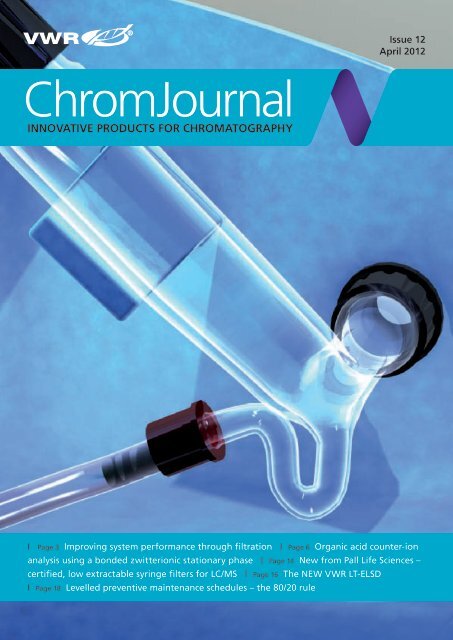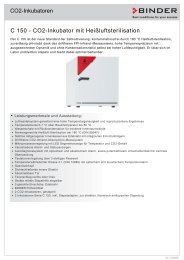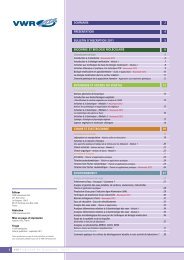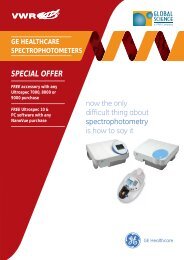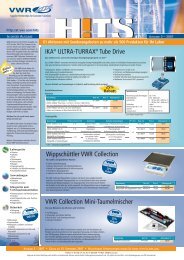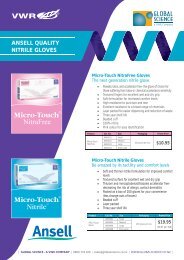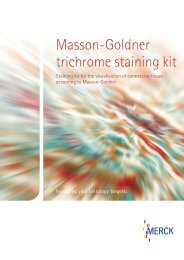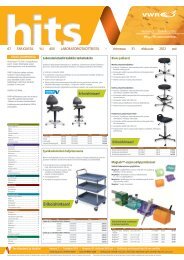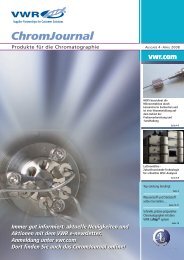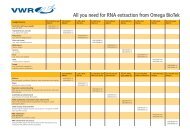You also want an ePaper? Increase the reach of your titles
YUMPU automatically turns print PDFs into web optimized ePapers that Google loves.
Issue 12April 2012ChromJournalInnoVAtIVe pRoducts foR chRomAtoGRAphyI Page 3 Improving system performance through filtration I Page 6 Organic acid counter-ionanalysis using a bonded zwitterionic stationary phase I Page 14 New from Pall Life Sciences –certified, low extractable syringe filters for LC/MS I Page 16 The NEW VWR LT-ELSDI Page 18 Levelled preventive maintenance schedules – the 80/20 rule
ChromJournalInnoVAtIVe pRoducts foR chRomAtoGRAphyedItoRIAlDear Reader,a new year has more meaning for us than just changing the date.It means introducing new innovative products and new supplierstogether with new applications and supporting information. allwith the purpose to help and support you with your activities inthe world of chromatography.this edition is full of just that.Read all about our new innovative VWR electronic lightscattering detector 90 which uses Blu-Ray ® technology.new applications with Merck-Millipore and Shodex columnsplus several interesting articles about maintenance andtroubleshooting.also in the year 2012, you can be sure that we keep on servingthe chromatography community. Be it in the (bio) pharmaceutical,university, govermental, life science, industrial or healthcaremarkets.Your chromatography teamPS, when you’ve finished reading this, take a quick look at theneW chromshop for great offers and fRee samples!Finally new supplies that will help you to deliver more accurateresults and gain efficiency.contentsImproving system performance through filtration. . . . . . . . . . . . . . . . . . . . . . . . . . . . . . . . . . . . . . . . . . . . 3VWR Collection total microliter vials. . . . . . . . . . . . . . . . . . . . . . . . . . . . . . . . . . . . . . . . . . . . . . . . . . . . . . 5organic acid counter ion analysis using a bonded zwitterionic stationary phase . . . . . . . . . . . . . . . . . . . . . 6neW generation monolithic silica columns for fast, high resolutiondrug separations without high pressures . . . . . . . . . . . . . . . . . . . . . . . . . . . . . . . . . . . . . . . . . . . . . . . . . . 7testing the reduction of emissions when using SCat SafetyCapson solvent bottles in laboratories part 2 . . . . . . . . . . . . . . . . . . . . . . . . . . . . . . . . . . . . . . . . . . . . . . . . . . . 8analysis of testosterones using a core enhanced technology accucore HPlC column . . . . . . . . . . . . . . . 10BDH Prolabo ® GC capillary PeStInoRM ® solvents for the new QueCheRS method . . . . . . . . . . . . . . . . . . 11SGe Diamond syringe range... brilliance from manual to autosampler and instrument applications. . . . . . 12neW from Pall Life Sciences – certified, low extractable syringe filters for LC/MS . . . . . . . . . . . . . . . . . . . 14the new VWR evaporative light Scattering Detector (elSD) . . . . . . . . . . . . . . . . . . . . . . . . . . . . . . . . . . . 16HPLC preventative maintenance....the 80/20 rule . . . . . . . . . . . . . . . . . . . . . . . . . . . . . . . . . . . . . . . . . . . 18EditorVWR International Europe bvbaResearchpark Haasrode 2020Geldenaaksebaan 4643001 LeuvenBelgiumCopywritingVWR International Europe bvbaLayout and typesettingMarketing Services VWRPrintingStork, Bruchsal, GermanyNo part of this publication may be reproducedor copied without prior permission by writing ofVWR International Europe.Run48.000 copiesPublication date: April 2012Due to the high sales volume of promoted articlessome items may be temporarily out of stock - VWRTerms and Conditions of Sale apply.2VWR InteRnatIonal I chromJournal Issue 12 I 2012
For more information on these products contact your local VWR sales office, sendan e-mail to chromjournal@eu.vwr.com or visit our website www.vwr.comImproving system performancethrough filtrationAuthors: John W. Batts, IV – technical Specialist;Gretchen Gora-Maslak, PhD – Product Managercompany: IDeX Health & ScienceBrand focus: Upchurch ScientificRecent advances inchromatographytechnology havefacilitated new thresholdsin the areas of rapiddrug discovery anddevelopment whileoffering enhanced overallsensitivity. However, assystem hardware hasbecome more advanced,so has the frequencyof experiencingperformance limitingchallenges with theequipment.Fortunately, byincorporating filtrationaccessories such as inletfilters, inline filters, andpre-column filters in thesystem’s fluid pathway,chromatographers canrealise more reliablesystem performanceand increased systemcomponent lifetime.Inlet filtersOne of the first places where contaminants canenter a fluid stream is in the solvent reservoir.Placing an inlet filter inside the reservoir at theend of the inlet tubing helps ensure the fluidstream remains free of physical contaminants, asa result protecting downstream equipment.Inlet filters typically have some distinguishingcharacteristics:• offer a large filtration surface area• Usually larger in porositythese features combine to help ensureunrestricted fluid flow while still offering goodprotection of the pump’s sensitive components.Additional features in some inlet filters allowsolvent to be drawn from very near the bottomof the solvent reservoir.Most popular inlet filters are easy to install,feature a porosity of 2 or 10 µm, and arereplaced every 6 to 12 months as part of aregular preventative maintenance programme.Inline filtersInline filters are usually placed immediately afterthe pump, where they capture any particlesstemming from seal wear travelling in the solventstream and as a result protect against blockagesand equipment damage.Like inlet filters, inline filters have some commoncharacteristics:Most standard inline filters incorporate afiltration disc (or “frit”) that can be quickly andeasily replaced for simple low cost preventativemaintenance. The most common filtration discsused with standard inline filters have a porosityof either 0.5 or 2 µm and are manufacturedfrom stainless steel or an inert polymer(e.g., PeeK ).Inline filters often feature internally threadedreceiving ports on both sides, allowing forthe quick connection of flow path tubing toeither side using standard, “high pressure”chromatography fittings.chromJournal Issue 12 I 2012 I VWR InteRnatIonal 3
For more information on these products contact your local VWR sales office, sendan e-mail to chromjournal@eu.vwr.com or visit our website www.vwr.comnew generation monolithic silicacolumns for fast, high resolution drugseparations without high pressures.Karin Cabrera and egidijus MachtejevasMerck MilliporeUsing a novel newdesign monolithic silicacolumn (Chromolith ®High Resolution RP-18e),fast, high resolutionseparations wereachieved for variousdrug mixtures withoutthe high pressurecharacteristics of modernparticulate technology.figure 1. 1 µl injection of sevenbeta-blockers (atenolol 100µg/ml, pindolol 300 µg/ml,metoprolol 155 µg/ml, bisoprolol100 µg/ml, labetalol 200 µg/ml,propanolol 20 µg/ml, alprenolol150 µg/ml) in mobile phase ona 100 x 4.6 mm Chromolith ®High Resolution RP-18e columnusing a 23:77 (v/v) acetonitrileand 20 mM potassiumdihydrophosphate buffer (pHadjusted to 2.5 with phosphoricacid) mobile phase at 2 ml/minflow rate; column back pressure76 bar. UV detection at 230 nm,column temperature 25 ºC.DescriptionIntroductionMonolithic silica technology has evolved as asignificant development in fast HPLC analysisover the last decade. as the true alternative toconventional particle packed column technology,monolithic silica columns are made of acontinuous single piece of high purity poroussilica. a sol-gel synthesis process is used, leadingto single particle rod columns, which possess abimodal pore structure with macro (flow path)and meso (active site) pores in the 1 µm and 140angstrom range. High performance results fromthe permeability efficiency of the fixed flowpathways in the highly controlled porosity of thesynthesised rigid silica skeleton. the resultingvery low operating back pressures compared toclosely packed spherical particles allow for moreflexible flow rates and solvent choice comparedto particulate columns, and enable highthroughput analysis without loss of separationefficiency and peak capacity. Monolithic silicacolumns are increasingly being used for qualitycontrol of drugs. easy and cost effectivemethod transfer offers great advantages overother trends toward fast HPlC analysis. Flowprogramming with monolithic columns provideadditional reduction of analysis time. Since thereis no particle bed to disturb, pressure shocksdo not affect its performance or lifetime. thepossibility for direct injection of biological fluidswithout pre-treatment have made it moreapplicable for bioanalysis [1]. Furthermore,the longer half life of monolithic columnsmade it more convenient for routine qualitycontrol work. Chromatographic separation andquantitation of complex mixtures by monolithiccolumns were made possible through columncoupling in series. Different derivatives ofmonolithic silica were already synthesised forversatile applications. Good result precision hasalready been confirmed on monolithic columns.In this section we are particularly focusing onthe importance and application of monolithicsilica columns in the quality control of drugsCat. No.Chromolith ® High Resolution RP-18e 25 - 4.6 mm 1.52020.0001Chromolith ® High Resolution RP-18e 50 - 4.6 mm 1.52021.0001Chromolith ® High Resolution RP-18e 100 - 4.6 mm 1.52022.0001Chromolith ® High Resolution RP-18e 5 - 4.6 mm guard column kit 1.52024.0001Chromolith ® High Resolution RP-18e 5 - 4.6 mm guard columns (pack of 3) 1.52025.0001to run large number of samples in a relativelyshort time, and so to save time, cost and effortin analysis. to date, hundreds of papers havebeen published describing the use of monolithiccolumns in various analytical fields whichinclude routine drug analysis and QC, food andenvironmental analysis, natural products analysisand bioanalysis [2].In this application note a separation of drugsubstances is presented. Seven beta-blockersare baseline separated in four minutes at 2 ml/min flow rate with just 76 bar back pressure (seeFigure 1). Even short columns have sufficientresolution to separate five drugs in less thanthree minutes (Figure 2). Both separationspossess high efficiency and high peak symmetry.Both of these applications can easily be adaptedto MS detection, by simply adding a postcolumn flow splitter to a MS detector for furthercharacterisation of the aPI.conclusionsSeparation of drugs is easily achieved on thenewly designed monolithic silica Chromolith ®High Resolution columns. this application noteillustrates that ultra-high efficiencies could bereached without ultra-high pressures.References1. E. Machtejevas, K.K. Unger, in: Jörg von Hagen (Editor),Proteomics Sample Preparation, Sample preparation forHPLC – based proteome analysis. 2008 Wiley-VCH, Weinheim,Germany, 245-264.2. M. Taha, A. Abed, S. El Deeb, in: K.K. Unger, N. Tanakaand E. Machtejevas (Editors), Monolithic silicas in separationscience, Quality control of drugs. 2011 Wiley-VCH, Weinheim,Germany, 189-206.figure 2. Separation of fivedrugs on Chromolith ® HighResolution RP-18e 25 - 4.6mm column. Chromatographicconditions: 2 μl injection of 100ppm of actaminophen (98 µg/ml), quinine (152 µg/ml), salicylicacid (140 µg/ml), diltiazem(81.2 µg/ml), verapamil (98.4µg/ml) in mobile phase; linearacetonitrile gradient from 1to 60% water with 0.1% tFain 1.8 min; flow rate 2 ml/min; column back pressure 31bar; UV detection at 230 nm,column temperature 25 ºC.chromJournal Issue 12 I 2012 I VWR InteRnatIonal 7
ChromJournalInnoVAtIVe pRoducts foR chRomAtoGRAphytesting the reduction of emissionswhen using scAt safetycaps onsolvent bottles in laboratoriesDipl.-Ing. Josef SparkSGS InStItUt FReSenIUS GmbH,Im Maisel 14, 65232 taunussteincommIsIonSGS Institut Fresenius GmbH received a writtenassignment from SCat europe GmbH to testthe reduction of emissions achieved by theuse of SCat SafetyCaps. test cabinet trialswere performed during which the amount ofemissions in the atmosphere were checkedregularly over a period of 7 days. acetonitrileand methanol were used as solvent components.test methodsacetonitrile. the determination was performedusing a silica gel tube for methanol or ananasorb-747 tube for acetonitrile. the analysiswas performed according to nIoSH 2000(methanol) and nIoSH 1606 (acetonitrile).the adsorbed material was extracted by solvent,and the extracted material analysed by capillarygas chromatography using a thermal evaporator.The detection was performed using a GC/MSsystem (ion trap), the selectivity was enhancedby chemical ionisation with water.meAsuRementsdetermining the atmosphericemissions by means of testcabinet trialstest cabinet trials were performed to determinethe emissions of methanol or acetonitrile into theatmosphere. For this purpose the test cabinetswere operated under the following definedconditions (based on DIn en ISo 16000-9):• temperature: 23 °C• atmospheric humidity: 50%• Product loading factor: 1 m 2 /m 3• air exchange rate: 0.5 per hour• Volume: 1000 ml bottle with or without anSCat SafetyCapSamples were taken at the outlet after 24 hours,3 days and 7 days, in order to determine theatmospheric concentration of methanol andMethanol emission in test chamberdetermination of the atmosphericconcentration of methanol oracetonitrile in a test cabinetAcetonitrile test cabinetconcentration in mg/m 3ResultsMethanol test cabinetconcentration in mg/m 3TimeWithout cap With cap Without cap With cap24 h 800 5 660 23 d 770 3 640 17 d 730 1 630 1Assessment of the atmosphericconcentrations determined duringthe test cabinet trialsConcen ntration (mg/m 3 )70060050040030020010001 3 7DaysSolvent bottle withoutSafetyCapSolvent bottle withSafetyCapWorkplace exposure limitto determine the emissions from an opensolvent bottle in comparison to a solvent bottleclosed with a SCat SafetyWasteCap, eachsolvent bottle was placed in a test cabinet andthe emissions of methanol or acetonitrile weremeasured after 1 day, 3 days and 7 days.It becomes evident that with a solvent bottlewithout a SafetyCap in the test cabinet,despite a continual air change, a concentrationof methanol of 630 - 660 mg/m 3 could beestablished, whereas with a solvent bottle withSafetyCap the results showed concentration ofonly 1 - 2 mg/m 3 .8VWR InteRnatIonal I chromJournal Issue 12 I 2012
For more information on these products contact your local VWR sales office, sendan e-mail to chromjournal@eu.vwr.com or visit our website www.vwr.comthis shows that with the SCat SafetyCapa significant reduction, almost to 0, of themethanol concentration in the test cabinet wasachieved, as a result falling significantly shortof the workplace exposure limit tRGS 900of 270 mg/m 3 . In contrast to this, when theSCAT SafetyCap was not fitted, the methanolconcentration in the test cabinet was 630 -660 mg/m 3 , which is significantly higher thanthe workplace exposure limit, resulting in anexposure which can affect the health of theemployees in the laboratory.Similar results were achieved in the test chambermesurements with acetonitrile. Using a SCatSafetyWasteCap, a concentration of 1 - 5 mg/m 3could be observed, while on the contrary, withthe bottle without any SafetyCap, the acetonitrileconcentration, despite a continual air change,was 730 - 800 mg/m 3 .Concen ntration (mg/m 3 )9008007006005004003002001000Acetonitrile emission in test chamber1 3 7Solvent bottle withoutSafetyCapSolvent bottle withSafetyCapWorkplace exposure limita comparison of the test cabinet emission resultswith the acetonitrile limit value to tRGS 900 of34 mg/m 3 shows that without the SCat cap, theacetonitrile concentration is significantly higherthan the workplace exposure limit. In contrast tothis, when the SCAT SafetyCap is fitted to thebottle of solvent, the acetonitrile concentration issignificantly minimised, so that it is considerablylower than the workplace exposure limit to tRGS900 of 34 mg/m 3 .DayssummARyIn summary, it is evident that the solvent emissions could be significantly reduced by the SCATSafetyCaps. In this respect, the use of SCat SafetyCaps can be expected to lead to a clear reductionof the exposure of solvents in the atmosphere in a laboratory.as a result the reduction in the solvent concentration in the atmosphere can be assumed to beof a similar proportion as was described above, leading to a significantly lower health risk for theemployees concerned.Furthermore, SCAT SafetyCaps significantly minimise the risk of contamination of solvent-free blanksamples in laboratories, so the use of SCat SafetyCaps can also be considered a measure ofquality assurance.chromJournal Issue 12 I 2012 I VWR InteRnatIonal 9
ChromJournalInnoVAtIVe pRoducts foR chRomAtoGRAphyAnalysis of testosterones usinga core enhanced technologyAccucore hplc columnJoanne Gartland, Thermo Fisher Scientific, Runcorn, Cheshire, UKThis demonstrates theuse of the ThermoScientific Accucore RP-MS HPLC column forthe fast analysis of threetestosterones.Introductionaccucore HPlC columns use Core enhancedTechnology to facilitate fast and high efficiencyseparations. The 2.6 μm diameter particles arenot totally porous, but rather have a solid coreand a porous outer layer. the optimised phasebonding creates a series of high coverage,robust phases. accucore RP-MS uses anoptimised alkyl chain length for more effectivecoverage of the silica surface. this coverageresults in a significant reduction in secondaryinteractions and as a result highly efficient peakswith very low tailing. the tightly controlled 2.6μm diameter of Accucore particles providesmuch lower backpressures than typically seenwith sub 2 μm materials. 11-ketotestosterone,19-nortestosterone and epitestosterone are allrelated to testosterone. 11-ketotestosteroneis an oxidised form of testosterone.19-nortestosterone contains an additionalmethyl group in comparison to testosteroneand epitestosterone and is an inactive epimer oftestosterone. all three compounds are anabolicsteroids, which promote protein synthesis withincells, particularly in muscles. 19-nortestosteronefigure 1.Chromatogram for 11-ketotestosterone (1), 19-nortestosterone (2) andepitestosterone (3) separated on an accucore RP-MS 2.6 μm100 × 2.1 mm columnoccurs naturally at low levels (0.4 ng/ml) in thebody and is routinely tested for in athletes.the separation of these three compounds andmore significantly the speed of analysis aredemonstrated in this application.experimental conditionssample preparationWorking standard contained 50 μg/ml of eachtestosterone in mobile phasecolumnaccucore RP-MS 2.6 μm, 100 × 2.1 mm (Cat.no. 554-1885)Measured pressure: 300 barAccela hplc systemColumn temperature: 40 °CInjection volume: 1 μlFlow rate: 0.6 ml/minUV detection: 54 nmmobile phase60:40 (v/v) water/acetonitrileconsumablesHPlC grade waterHPlC grade acetonitrileNSC Mass Spec Certified 2 ml clear vial withblue bonded PtFe silicone capResultsthe analysis was carried out on an accucore RP-MS 2.6 μm, 100 × 2.1 mm column.11-ketotestosterone, 19-nortestosterone andepitestosterone eluted in under 2 minutes(Figure 1).Replicated injections of the testosterone mixshowed that accucore RP-MS produced stableand reproducible results (table 1).table 1. Method precision (%RSD) for 11-ketotestosterone, 19-nortestosteroneand epitestosterone (data calculated from six replicate injections)Peak 111-ketotestosteronePeak 219-nortestosteroneAsymmetry 1.48 1.28 1.11%RSD Tr 0 0.05 0.06%RSD peak area 0.31 0.26 0.44Peak 3epitestosteroneconclusionsaccucore RP-MS columns successfullyseparated 11-ketotestosterone,19-nortestosterone and epitestosterone in lessthan 2 minutes, providing an excellent choice forthe fast analysis of testosterones, allowing highsample throughput.DescriptionCat. No.Accucore RP-MS 2.6 μm, 100×2.1 mm 554-188510VWR InteRnatIonal I chromJournal Issue 12 I 2012
For more information on these products contact your local VWR sales office, sendan e-mail to chromjournal@eu.vwr.com or visit our website www.vwr.comVWR Bdh pRolABo ® the chemIcAl BRAnd fRom VWR InteRnAtIonAlBdh pRolABo ® Gc cApIllARypestInoRm ® solVents foR theneW QuecheRs methodthe new european Standard en 15662,applicable in France since January the 31st2009, describes the QueCheRS method asa versatile method for the determination ofpesticide residues by GC/MS and LC/MS, withextraction/partition with acetonitrile and cleanup by dispersive SPe in plant foods such as fruits,(including dried fruits), vegetables, cereals andtheir derivatives.this new method provides;• Quick purification• ease of use• Cheap analysis with less solvent consumption• Efficient method with a wide range ofdetectable pesticides• Safety improvementThis method allows the purification of a lot ofsubstances with different polarities - more than500 pesticidesBenefits of using GC capillarypestInoRm ® solvents• Guaranteed with extremely low organic andhalogenated derivatives to avoid contamination• evaporation residue less than 5 ppm• Impurities causing interfering peaks on gaschromatogram are not greater than:• 5 ng/l of lindan by electroncapture detection• 10 ng/l of octanol byflame ionisation detectionPurified from selected raw materials under ISO9001 conditions, these solvents are also;• Filtered at 0.2 µm• Bottled under nitrogen• Fitted with caps with PtFe liners to preventcomtamination• Packed in 2.5 l glass bottles with 45 closuresDescription Assay Acidity Residue Water Organicresiduemin. %max.meq/gHalogenatedresiduemax. % max. % max. ng/ml max. ng/lCat. No.Acetone 99.9 0.001 0.001 0.2 10 5 83960.320Dichloromethane, stab MB* 99.9 0.001 0.001 0.05 10 5 83961.320N-Hexane 99.0 0.001 0.001 0.01 10 5 83962.320Ethyl acetate 99.8 0.001 0.001 0.05 10 5 83963.320N-Pentane 99.0 0.001 0.001 0.01 10 5 83964.320Petroleum spirit, 40....60 °C 90.0 0.001 0.001 0.05 10 5 83965.320Methanol 99.9 0.001 0.001 0.01 10 5 83966.320*Stab MB: stabilised with 50 ppm of 2-Methyl-2-buteneHere is a selection of some commonly used LC/MS solvents and other reagents important for this method.Description Pk Cat. No.Acetonitrile HiperSolv ® CHROMANORM ® for HPLC LC/MS 2.5 l 83640.320Methanol HiperSolv ® CHROMANORM ® for HPLC LC/MS 2.5 l 83638.320Water HiperSolv ® CHROMANORM ® for HPLC LC/MS 2.5 l 83645.320Ammonium formate AnalaR NORMAPUR ® 500 g 21254.260Magnesium sulphate anhydrous AnalaR ® NORMAPUR ® 500 g 25164.265Sodium chloride AnalaR ® NORMAPUR ® 1 kg 27810.295Tri-sodium citrate dihydrate AnalaR ® NORMAPUR ® 500 g 27833.260Sodium hydroxide 5 mol/l, 5N AVS ® TITRINORM ® 1 l 31624.290chromJournal Issue 12 I 2012 I VWR InteRnatIonal 11
ChromJournalInnoVAtIVe pRoducts foR chRomAtoGRAphysGe diamond syringe range...brilliance from manual to autosamplerand instrument applicationsThe Diamond syringe range fromSGE offers a never before seenlevel of durability, clarity andaccuracy in the laboratory. Noother syringe range provides suchbrilliance! New applications arethen possibledurabilityenhancements to the Diamond syringesresult in:• Improved solvent resistance• Greater temperature ranges• Increased operational smoothnessthese improvements deliver longer syringelife, and an improved cycle life of up toten times that of a similar non Diamondsyringe.Diamond syringes for autosamplers andinstrumentsDiamond syringes for autosamplers andinstruments incorporate a vibrant colourscheme distinguished by volume enablingeasy identification of installed syringes.AccuracyDiamond syringes offer a new level ofaccuracy in the laboratory. SGe Diamondsyringes have been enhanced to eliminateareas where fluid can become trappedand potentially cause carry-over. a closerfit between plunger tip and PTFE insert atthe zero position, a tighter fit between thePtFe insert and glass barrel and improvedneedle attachments, all help to reducecarry-over.SGe syringesCompetitors syringethe Diamond syringe designenhancements have significantly reducedadhesive from the fluid path. This adds tothe durability of the syringe and reducesthe risk of sample interaction with theadhesive.claritydiamond syringes formanual useManual Diamond syringes have a sharpblack scale and ‘bright white’ backingmaximising contrast. the syringes are easyto-usewith excellent readability, aidingconsistent delivery of samples andprecise results.SGe Diamond syringeThe GC/MS traces below show noadhesive contamination with Diamondsyringes compared to other syringescurrently available.GC/MS traces from three syringes currently available in the marketshowing peaks identified as being components of adhesives.12VWR InteRnatIonal I chromJournal Issue 12 I 2012
For more information on these products contact your local VWR sales office, sendan e-mail to chromjournal@eu.vwr.com or visit our website www.vwr.comFurther enhance your Syringe Brilliance bycoupling a Diamond syringe to eVol ® , theworld’s first digital analytical syringe.eVol ® is a complete dispensing solutionwith a broad range of functions anduses. the winner of an R&D award forInnovation, eVol ® revolutionises the wayyour laboratory works and the paceof sample processing. Coupled with aDiamond syringe, eVol ® speeds up andsimplifies workflow, improves accuracy andreproducibility and standardises results, allindependent of operator skill.eVol ® is the coupling of two precisiondevices: a digitally controlled electronicdrive and an XCHanGe ® (patent pending)enabled analytical Diamond syringe.“DISPENSING ACCURACY - Visitors at a recent Pittsburgh Conference on Analytical Chemistry and AppliedSpectroscopy (Pittcon) used both a manual syringe and an eVol ® coupled with a Diamond syringe todispense a target volume of 491.5 µl. the results demonstrate eVol ® 's significantly superior accuracy andreproducibility independent of operator.”the result is a digitally controlledpositive displacement dispensing systemprogrammable to reproducibly andaccurately perform a wide variety ofliquid handling procedures. Unlike airdisplacement devices, eVol ® is the perfectsolution for accurately aspirating anddispensing both aqueous and nonaqueous liquids.the range of eVol ® analytical Diamondsyringes accurately aspirates and dispensesvolumes from 200 nl to 500 μl atvariable speeds. eVol ® is easily calibrated,complies with stringent global standards,is programmable and can be passwordprotected. It is ergonomic, comfortableand easy-to-use.use eVol ® for anymanual syringe application….Preparation of internal calibration standards;addition of internal calibration standards tosamples; addition of derivatisation reagentsto samples; addition of non aqueous reagentsto samples; preparation of surrogate samples;instrument injections (GC/LC).Sample matrix exchange and clean-up usingMePS; serial dilutions; micro-titrations;tlC spotting; routine dispensing; precisemeasurement; spiking; quantitative NMR(access the bottom of your tubes).examples of how award winning eVol ® coupled with a Diamond syringe improves laboratoryProcess Without eVol ® With eVol ® eVol ® benefitsStandardpreparationAddition ofstandardsDelivery ofderivatisationagentsSerial dilutionsStandards prepared in a large volume flask. Fromthis standard aliquots are individually dispensedinto autosampler vials.Small amounts of standard aspirated and dispensedinto all samples before being transferred to anautosampler vial.Laboratory staff required to work in a fume hoodwith potentially hazardous materials, to preparecombinations of derivatisation agents in open vials.Transfer of a small amount of solution to anothercontainer. Solvent added to achieve the requiredvolume. This is repeated multiple times to obtainthe required final accurate concentration.standards are made up directlyin the vial, including the make upsolvent.one aspiration and a fast seriesof repeated accurate dispensesdirectly into vials.process completed with eVol ®programmed to aspirate an amountof solvent or agent and thendispense aliquots into sealed vials,single-handed operation.one aspiration of the solutioncan be dispensed directly into thesolvent to achieve the requiredaccurate concentration.• Less glassware usage• Reduces waste fluid• Significant time saving• Improved accuracy and reproducibility• Significant time saving• Improved accuracy and reproducibility• Improved operator safety, lower spill and splash risk• Ergonomic benefits behind fume hood screen• Improved accuracy and reproducibility• Less glassware use• Complete workflow simplification• Significant time savings• Improved accuracy• Less solvent required• Less glassware usedchromJournal Issue 12 I 2012 I VWR InteRnatIonal 13
ChromJournalInnoVAtIVe pRoducts foR chRomAtoGRAphyNew from Pall Life Sciences –certified,low extractable syringe filters for LC/MSLiquid Chromatography/Mass Spectrometry(LC/MS) is a powerfulanalytical analysistechnique used forvarious applications.It is often used fordetection of a broadrange of analytes,structural elucidation,polymer characterisation,pharmacokineticsstudies, proteomics, andquantitative analyses.Extraction and leachingof chemical compoundsfrom filters are majorconcerns in analyticalsample preparations,particularly whenusing chromatographictechniques interfacedwith MS detectorsfor analysis. Theseextractable andleachable materials,when not controlled,may jeopardise analyticalresults and datainterpretation.Pall Life Sciences is proudto present a new uniqueAcrodisc ® MS syringe filterwith WWPTFE membrane.This Acrodisc ® MS syringefilter has extremely lowlevels of extractables andis certified for LC/MS. Thefollowing extractablesstudy demonstrates whythe Acrodisc ® MS syringefilter is ideal for LC/MSsample preparation andhow it’s performanceaids in obtaining accurateexperimental results.the WWptfe membranePall life Sciences WWPtFe membraneis an optimised water-wettablepolytetrafluoroethylene membrane which offersextremely low extractable levels with good flowrates and retention efficiency. The WWPTFEmembrane also provides excellent chemicalcompatibility with both aqueous and mildorganic solvents.extractables studythe cleanliness of three different types ofsyringe filters - Pall’s Acrodisc ® MS syringe filter,and two alternative syringe filters - is evaluatedbased on the level of extractables in the filtereffluents using LC/MS under the same filtrationand analytical conditions. Ten filters from onelot of product are tested for each of the threefilter types.IntensityIntensityRetention time (Minutes)D, Hydrophilic PtFeC, PVDFB, acrodisc MSa, Controlfigure 1. overlaid tIC chromatograms usingacetonitrile:water (50:50, v/v) as the testfluid. (A - orange) Control, (B - green) Effluentfrom Pall’s acrodisc ® MS syringe filter, (C -purple) alternative PVDF filter, and (D - black)alternative hydrophilic PTFE filter.D, Hydrophilic PtFeC, PVDFB, acrodisc MSa, Controlthe analytical procedure for this evaluationconsists of an UPLC (Ultra Performance LiquidChromatography) gradient elution methodcapable of detecting a broad range of organiccompounds in the eS+ (electrospray positive)MS ionisation mode. Pure acetonitrile, 50%acetonitrile in water, pure methanol, and 50%Methanol in water are the four test fluidsbased on the most commonly used solvents foranalytical sample preparations.Representative chromatograms are provided inFigures 1 – 4In Figures 1 and 2, it is observed that theAcetonitrile:Water (50:50, v/v) mixture tends toshow more extractable peaks in the hydrophilicPTFE and PVDF filters than pure Acetonitrile.It is also noticed that the performance of theacrodisc ® MS syringe filter is more consistentregardless of the strength of the acetonitrilecontaining solvent.IntensityIntensityD, Hydrophilic PtFeC, PVDFB, acrodisc MSa, ControlRetention time (Minutes)figure 2. overlaid tIC chromatograms usingpure acetonitrile as the test fluid.(A - orange) Control, (B - green) Effluent fromPall’s acrodisc ® MS syringe filter, (C - purple)alternative PVDF filter, and (D - black)D, Hydrophilic PtFeC, PVDFB, acrodisc MSa, ControlRetention time (Minutes)Retention time (Minutes)figure 3. overlaid tIC chromatograms usingMethanol:Water (50:50, v/v) as the test fluid.(A - orange) Control, (B - green) Effluent fromPall’s acrodisc ® MS syringe filter,(C - purple) Alternative PVDF filter, and(D - black) Alternative hydrophilic PTFE filter.figure 4. overlaid tIC chromatograms usingMethanol as the test fluid. (A - orange)Control, (B - green) Effluent from Pall’sacrodisc ® MS syringe filter, (C – purple)Alternative PVDF filter, and (D - black)Alternative hydrophilic PTFE filter.14VWR InteRnatIonal I chromJournal Issue 12 I 2012
For more information on these products contact your local VWR sales office, sendan e-mail to chromjournal@eu.vwr.com or visit our website www.vwr.comIn Figures 3 and 4, it is noted that with respectto the hydrophilic PTFE filters, the pure Methanoleffluent contains higher extractable levels thanthe effluent from the Methanol:Water (50:50,v/v) solvent. The trend is reversed in the PVDFfilters. There are more extractables in theeffluent of the Methanol:Water (50:50, v/v)solvent than in the effluent of pure Methanol.Again, the level of extractables in the effluentsof the acrodisc ® MS syringe filter remainsextremely low regardless of the use of pure ordiluted Methanol.conclusionPall’s LC/MS certified Acrodisc ® MS syringe filteris qualified to ensure that effluents contain verylow levels of extractable/leachable materials.It is suitable for LC/MS analysis of aqueoussolutions and mild organic solutions based onthe test conditions used in this study.ABout the AcRodIsc ® MS SyrINGe fILterLC/MS certified – Minimise interference in yourLC/MS results with the Acrodisc ® MS syringefilter. The first LC/MS certified filter withextremely low levels of extractables.Low ion suppression/enhancement – Reducethe need for retesting. The certifiably low levelof extractables of the acrodisc ® MS syringefilter will reduce the risk of matrix effects thatinterfere with the ionisation process, which isthe heart of the LC/MS technique.protective packaging design – Save moneyand prevent downtime due to accidentalcontamination and subsequent disposal ofcontaminated filters. Acrodisc ® MS syringe filtersare packaged into five separate tubes to protectthem from external sources of extractables.While one tube is in use, the others are keptsealed and protected.excellent chemical resistance – Use thisuniversal filter for all your LC/MS samples.low protein binding – Get accurate andconfident quantitative results. There is minimalprotein adsorption with acrodisc ® MS syringefilters.particulate retention – Using acrodisc ®MS syringe filters will protect your columns andinstrument from particulate build-up, makingyour columns last longer and your LC/MSperform more consistently.To obtain a free sample pack of the new uniqueLC/MS certified Acrodisc ® MS syringe filter orto obtain more information on Pall life Sciencesrange of analytical sample preparation products,simply contact your local VWR customer servicedepartment or visit www.pall.com/labDescription Pk Cat. No. PriceAcrodisc ® MS syringe filter, WWPTFE membrane, 0.2 μm, 25 mm 50 214-0287Acrodisc ® MS syringe filter, WWPTFE membrane, 0.2 μm, 25 mm – sample pack 3 PALLSMS-3201 FREE**one per customer onlychromJournal Issue 12 I 2012 I VWR InteRnatIonal 15
ChromJournalInnoVAtIVe pRoducts foR chRomAtoGRAphythe new VWR evaporative lightscattering detector (elsd)Introduction:the new VWR elSD 90 with theVWR-Hitachi ChromasterAdvantages of elsd:• nearly Universal (ideal for Unexpected analyteDetection).• Compatible with gradients• Mass Response Detector• Simple and robust (ideal for methoddevelopment)examples of applications where theVWR elSD 90 is particularly suited are:• Carbohydrates (mono, di and oligosaccharides)and polyols obtained with a gradient elution.• Polar and non polar lipids, a very convenientand efficient alternative to GC analyses• amino acids without any tedious derivationstep before detection• Water and fat soluble vitamins analysedsimultaneously• Inorganic ions without the use of anyadditional equipment such as ion suppressors• organic and phenolic acidsColumn temperature: 40 °Celuent a: Watereluent B: acetonitrileIsocratic: 28% A/72% B, eluent °assed mixed by the pumpFlow rate: 1.0 ml/min, pressure: 79 barInjection volume: 20 µlStop time: 15 minelSD conditions: Drift tubetemperature: 50 ºC, n2 gas pressure:3.5 bar, gain 12,filter 6sAmong the detectors available in LiquidChromatography, the evaporative light-Scattering Detector (elSD) has become, in recentyears, a well established instrument thanks toseveral theoretical studies based on fundamentalinvestigations and numerous applicationsprovided during the last thirty years.elSD is considered as an almost universal,powerful and cost effective detection technique,and is ideally suited to the majority of liquidchromatography applications. today the powerof this detection mode is further extended witha new model which uses a genuine and efficientlow-temperature technology combined withan innovative detection chamber, providing thehighest sensitivity with all compounds includingthose that are semi-volatile and thermo-labile.Descriptionanother great advantage with elSD is that allnon volatile analytes without a chromophore,can be detected as the elSD is a mass responsedetector.to show the improvements with the new VWR-Hitachi Chromaster HPlC system, we presentsome specific examples as well as benefits ofusing the Chromaster with the VWR elSD 90.the chromatograms in Figures 1 and 2 used thefollowing systems set-up;Column:DescriptionShodex AsahipakNH2P-50 4EVWr-Hitachi Chromaster system configurationCat. No.Chromaster 5110 pump with AP valve with auto purge valve, washing mechanism, e-Line cable (0.5 m) 903-05016 channel Degassing unit (built-in accessory for 5110 pump) 4 channels for solvents, 2 channels for AS washingsolution, 480 µl/flow path903-0503700 µl (static mixer), for conventional (0.4 - 1.8 ml/min) use. Standard accessory for LPG Unit for 5110 903-0506Low-pressure Gradient Unit for 5110 (built-in accessory for 5110 pump), proportioning valve, conventional mixer, tubes 903-0502Chromaster 5210 Autosampler Sample rack (1.5 mlx120), 175 µl syringe (0.1 to 100 µl) e-Line cable (0.8 m). 903-0509Chromaster 5310 Column Oven e-Line cable (0.5 m) is equipped as standard accessory. Power unit is built-in. 30 cmcolumn x 3 pcs can be loaded.903-0520Chromaster Organizer Cabinet for solvent bottles. Power supply function for Pump, AS, IFC Board, Detectors 903-0537GUI Controller for Chromaster 5000 series Interface Control Board 903-0546Evaporative Light Scattering Detector 90 903-0267Poresize(Å)Particlesize(µm)I-øxL(mm)Cat. No.100 5 250x4.6 554-088016VWR InteRnatIonal I chromJournal Issue 12 I 2012
For more information on these products contact your local VWR sales office, sendan e-mail to chromjournal@eu.vwr.com or visit our website www.vwr.comVWR elSD 90VWR elSD 85ELSD with Chromaster High Frequency MixingelSD with Chromaster standard mixingfigure 1. chromatogram of fructose, Glucose andMaltose, each 10 ug/mlthe elSD 90 is twice as sensitive as the elSD 85.However, the sensitivity improvement can varybetween factor 2 and 6 depending on thenebulisers used.figure 2. chromatogram of fructose, Glucoseand Maltose, 1.25 ug/ml.Shows an improved signal to noise ratio by usingthe Chromaster High Frequency Mixing (HFM). Thisdemonstrates that the more efficient mixing of theHFM pump mode can improve the sensitivity of anelSD when it is used together with a Chromastersystem. This is of great benefit when only low analyteconcentrations are available.comparison of other technologiesCompared to existing technologies, the elSD90 gives improved peak efficiency. This leadsthe elSD 90 to be particularly suited as adetector for fast lC. Furthermore, other results,(not reported here) show that the new SeDeX90LT benefits from both the Low-Temperaturetechnology and a new optical head designbased on a laser, which results in an outstandingsensitivity increase with limits of Detection(n=3) down to the low nanogram and even tothe sub nanogram levels (e.g. 500 pg for Stearicacid and octadecanol, 600 pg for Mg, 700 pgfor eicosanol).light sourcethe sensitivity improvements arise owing toan improvement in the light source. the elSD90 uses a blue violet laser light source at 405nm instead of the blue leD light source on the85 model. this was made possible due to thedevelopment of the light source in Blu-Ray ®disk technology. 405 nm corresponds to themaximum sensitivity of the Photo Multiplyertube (PMt). Having a laser based light sourcealso gives a further advantage of higher outputpower than the blue leD light source at 10 mWas well as the beam being more focused.figure 3Efficiency, peak width comparedto Condensation nucleation lightScattering Detector (CnlSD)and Charged aerosol Detectiontechnology (CaDt): Peak Width(Hydrocortisone 100 ppm)Injection: 1 µlcolumn: nonemobile phase: ACN/H2O (50:50)flow rate: 0.25 ml/mindetector: 40 °C, 4.0 bars, G8U-HPlC nebulizerVWR elSD 90CnlSDCaDteasy set-up with eZchrom elitethe elSD 90 can be fully controlled with theexisting eZChrom drivers for 80 and 85. thedetector is combined with the Chromastersystem modules through the ChromasterMaintenance software during instrument set-up.The temperature, gain and filter settings for theelSD 90 are very simple to set.In summary:The new VWR ELSD 90 shows significantsensitivity improvement over the elSD 85 andwhen used with the Chromaster, the superiormixing capabilities of the HFM mixing make fora truly powerful analytical tool.Please call your local VWR Chromatographyspecialist to request further information.chromJournal Issue 12 I 2012 I VWR InteRnatIonal 17
ChromJournalInnoVAtIVe pRoducts foR chRomAtoGRAphylevelled preventative maintenanceschedules – the 80/20 ruleWhen dealingwith HPLC systemmaintenance, the80/20 rule appliesmore often than not.Typically, 80% ofsystem problems canbe traced to about20% of the system’scomponents. Similarly,80% of time is oftenspent fixing 20% of theproblems. If Murphy’sLaw is true, it seemsthere is almost a 100%chance that theseproblems will occurat the worst possibletime! So whether akey interface starts toleak or a check valvestarts to stick at themost inopportunemoment, it is goodto develop a regularand well definedseries of preventativemaintenance (PM)procedures to keepHPLC systems runningsmoothly.Why conduct preventativemaintenance?as with any mechanical system, periodic PMprocedures will keep an HPlC instrumentrunning at peak performance. In addition, thesesame PM’s may help prevent secondary ortertiary damage that can result when a particularcomponent fails to do what it is supposed todo. Because of this, many regulatory agenciesoverseeing specific industries require that eachHPlC instrument has its own maintenance logbook as well as a specific PM protocol in place.levelled preventative maintenanceMany HPlC service teams already use standardPM procedures and parts. However, becausemany PM parts tend to require replacement atdifferent intervals, a number of forward thinkingand cost conscious service organisations havebegun to use a type of levelled PM schedule(sometimes defined as basic, advanced, andcomprehensive PM) to reduce costs and savetime to an even greater degree.how to create your ownpreventative maintenance planWith any HPLC or UPLC system, the firstchallenge for most service organisations is toidentify key components that tend to needreplacement – and how regularly. Becausea host of factors will affect this, a goodguide for this process is the HPlC instrumentmanual itself. the experiences of many CtScustomers have been that the replacementschedules specified by the original equipmentmanufacturer (oeM) can be an overkill. So, whilean instrument manufacturer may prescribe acomprehensive PM every 6 to 12 months, serviceorganisations often find that only certain partsneed to be changed at this point, while otherscan be changed every 12 to 24 months or evenevery 24 to 36 months.after years of supplying thousands ofdistribution partners and end users around theglobe, CtS recommends the following steps increating a comprehensive PM plan:• Identify and isolate parts that seem to needreplacement on a less frequent basis than theoeM recommends, typically with input frominternal and external subject matter expertsfamiliar with the instruments and applicationsused within a specific organisation. In addition,instrument specific chat rooms or user groupscan often provide valuable input as well• Test hypotheses by changing out specificparts on a less frequent basis, monitoring keylocations on the instrument and comparingtest results to ensure that performance levelshave not been adversely affected• Document component life and any failure ratesto estimate expected life of specific parts forfuture PM’s• establish new benchmarks for the replacementof specific parts• Develop a two or three tiered PM schedulethat fits the needs of your organisation andbudget• Continue monitoring key components andrefining replacement schedules to better fit theneeds of the organisation being servedWhat parts to replace and whenSome of the items to consider replacing aspart of an HPlC PM program include lamps,plunger seals, and inline filters. Other commonlyreplaced items are check valves, active inletcartridges, needles and needle seats, rotor seals,plungers, and mobile phase filters.18VWR InteRnatIonal I chromJournal Issue 12 I 2012
For more information on these products contact your local VWR sales office, sendan e-mail to chromjournal@eu.vwr.com or visit our website www.vwr.comDepending on instrument usage, certain PMprocedures may need to be performed everyquarter or every six months (e.g. many QA labsand contract labs operate around the clock,requiring more frequent PM). A good rule ofthumb is that PM should be performed at thevery least on an annual basis. as noted above,however, it is also cost effective to develop atiered programme with items like plunger sealsand filter frits being replaced more frequentlythan check valves or rotor seals. For example:Typical partsFrequency ofchange-outTypical time frameSeals, filters Most frequent 3, 6 and 12 monthsNeedles andneedle seatsModeratefrequency6, 12 and 24 monthsCheck valves Less frequent 12, 24 and 36 monthsImplementing a levelled PM programme andperforming necessary system maintenance is notoverly complicated or time-consuming. everysystem and organisation is different. as a result,PM parts, procedures and change-out schedulesmay well vary from customer to customer, frominstrument to instrument, and from applicationto application. So a forward thinking serviceteam will systematically develop a PM schedulethat fits the needs of the organisation it serves.preventative maintenance kitsIn order to make your PM procedures lesspainful and more efficient, CTS has created arange of PM kits for various HPlC pumps andauto samplers. VWR are now able to offernumber of these kits to better serve itscustomer base.Cost savings can be significantat the beginning of this article, it was statedthat roughly 80% of system problems occurwith just 20% of the system’s components.Similarly, 80% of our time is often spent fixing20% of those problems. By implementing acomprehensive, well planned PM programmean organisation can often see a small amountof effort yield significant returns. It may or maynot be that a 20% investment in a well plannedPM programme will save 80% of overall servicecosts, but nonetheless, cost savings willbe significant.some WoRds ABoutVWR’s neW pARtneR ctsFor over 25 years, CTS has supplied high quality,OEM-equivalent parts for preventative maintenance(PM) of HPLC instruments. CTS replacement partsare used on thousands of HPLC instruments inanalytical and QA/QC labs. CTS have recentlyreceived ISO 9001:2008 certification as a followon to their earlier ISO 9001:2000 certification. Allaround the globe, CTS works primarily throughdistributors and service organisations to supplya broad range of pharmaceutical, biochemistry,chemical, environmental, clinical, and life sciencesorganisations, as well as academic institutions.For example:903-1015Seal pack rebuild kit for Waters alliance2690, 2690D, 2695, 2695D903-1019PM kit for Waters alliance2690, 2690D, 2695, 2695DchromJournal Issue 12 I 2012 I VWR InteRnatIonal 19
AustriaVWR International GmbHGraumanngasse 71150 WienTel.: 01 97 002 0Fax: 01 97 002 600E-mail: info@at.vwr.comBelgiumVWR International bvbaResearchpark Haasrode 2020Geldenaaksebaan 4643001 LeuvenTel.: 016 385 011Fax: 016 385 385E-mail: customerservice@be.vwr.comDenmarkVWR - Bie & BerntsenTransformervej 82730 HerlevTel.: 43 86 87 88Fax: 43 86 87 90E-mail: info@dk.vwr.comFinlandVWR International OyValimotie 900380 HelsinkiTel.: 09 80 45 51Fax: 09 80 45 52 00E-mail: info@fi.vwr.comFranceVWR International S.A.S.Le Périgares – Bâtiment B201, rue Carnot94126 Fontenay-sous-Bois cedexTel.: 0 825 02 30 30 (0,15 EUR TTC/min)Fax: 0 825 02 30 35 (0,15 EUR TTC/min)E-mail: info@fr.vwr.comGermanyVWR International GmbHHilpertstrasse 20aD - 64295 DarmstadtTel.: 0180 570 20 00*Fax: 0180 570 22 22*E-mail: info@de.vwr.com*0,14 €/Min. aus d. dt. Festnetz,Mobilfunk max. 0,42 €/Min.HungaryVWR Spektrum-3D Kft.Simon László u. 4.4034 DebrecenTel.: (52) 521-131Fax: (52) 470-069E-mail: info@spektrum-3d.huIreland / Northern IrelandVWR International Ltd /VWR International (Northern Ireland) LtdOrion Business CampusNorthwest Business ParkBallycoolinDublin 15Tel.: 01 88 22 222Fax: 01 88 22 333E-mail: sales@ie.vwr.comItalyVWR International PBI S.r.l.Via San Giusto 8520153 Milano (MI)Tel.: 02-3320311/02-487791Fax: 02-332031307/02-40090010E-mail: info@it.vwr.cominfo@internationalpbi.ithttp://it.vwr.comwww.internationalpbi.The NetherlandsVWR International B.V.Postbus 81981005 AD AmsterdamTel.: 020 4808 400Fax: 020 4808 480E-mail: info@nl.vwr.comNorwayVWR International ASHaavard Martinsens vei 300978 OsloTel.: 02290Fax: 815 00 940E-mail: info@no.vwr.comPolandLabart Sp. z o.o.A VWR International CompanyLimbowa 580-175 GdanskTel.: 058 32 38 210Fax. 058 32 38 205E-mail: labart@labart.plPortugalVWR International - Material de Laboratório,LdaEdifício NeoparkAv. Tomás Ribeiro, 43- 3 D2790-221 CarnaxideTel.: 21 3600 770Fax: 21 3600 798/9E-mail: info@pt.vwr.comSpainVWR International Eurolab S.L.C/ Tecnología 5-17A-7 Llinars Park08450 - Llinars del VallèsBarcelonaTel.: 902 222 897Fax: 902 430 657E-mail: info@es.vwr.comSwedenVWR International ABFagerstagatan 18a163 94 StockholmTel.: 08 621 34 00Fax: 08 621 34 66E-mail: info@se.vwr.comSwitzerlandVWR International AGLerzenstrasse 16/188953 DietikonTel.: 044 745 13 13Fax: 044 745 13 10E-mail: info@ch.vwr.comUKVWR International LtdCustomer Service CentreHunter BoulevardMagna ParkLutterworthLeicestershireLE17 4XNTel.: 0800 22 33 44Fax: 01455 55 85 86E-mail: uksales@uk.vwr.comAB-Apr2012Go to vwr.com for the latest news, special offersand details of your local VWR distributor.


